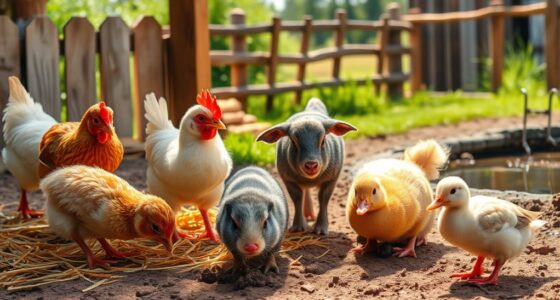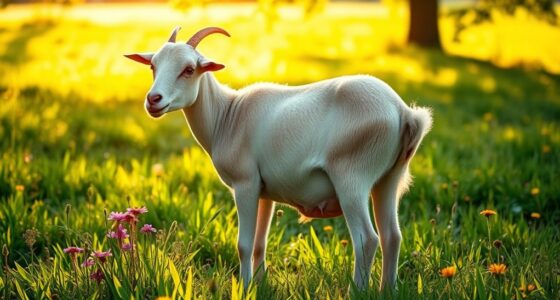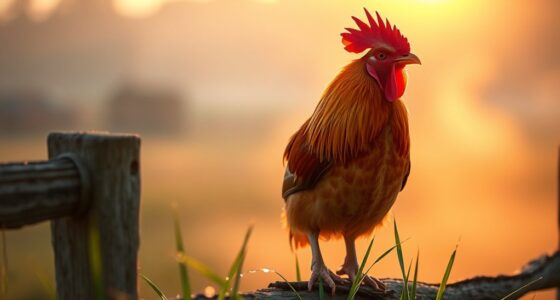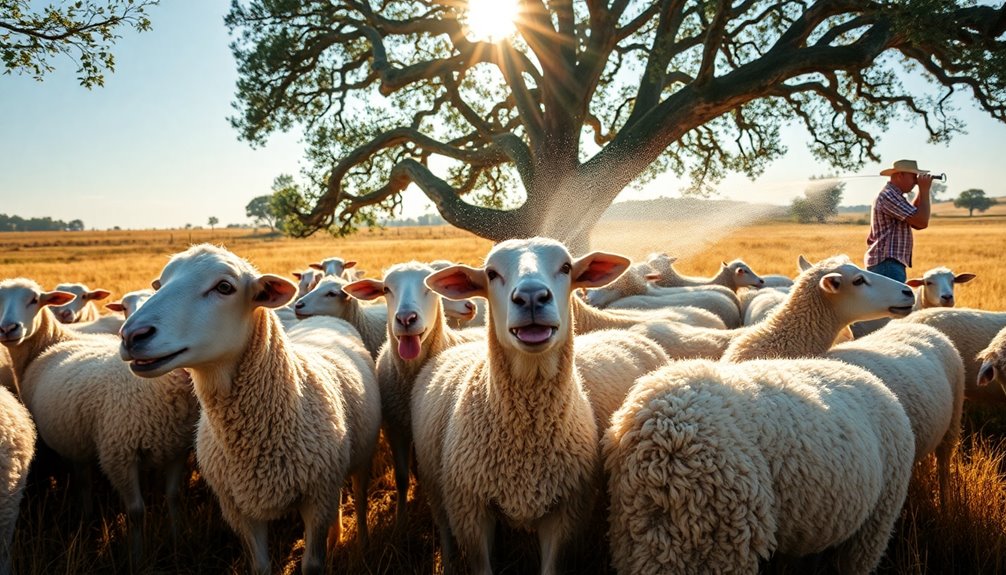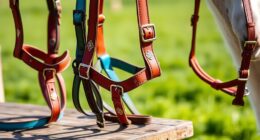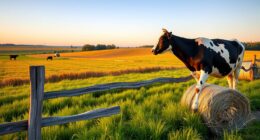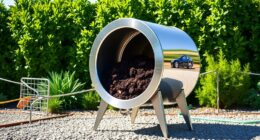To prepare broiler chickens for early-fall processing, adjust their feeding with higher nutrient density to support growth and supply clean, lukewarm water to prevent chilling. Optimize housing by ensuring proper ventilation and lighting, and monitor their health closely for signs of illness or stress. Enhance biosecurity to prevent seasonal diseases, and plan processing schedules to match their growth rate efficiently. Continue exploring these strategies to guarantee a smooth progression and a successful harvest.
Key Takeaways
- Adjust feeding and watering to meet increased energy needs and prevent chilling in cooler early-fall weather.
- Optimize housing conditions by maintaining proper ventilation, lighting, and temperature control to reduce stress.
- Monitor broiler health regularly, implement vaccination, and practice biosecurity to prevent seasonal disease risks.
- Schedule processing based on flock growth rates to ensure optimal harvest weight and maximize efficiency.
- Maintain storage quality and streamline operations to ensure product freshness and support timely market delivery.
Adjusting Feeding and Watering Regimens for Cooler Weather

As temperatures drop, it’s crucial to adjust your broiler chickens’ feeding and watering routines to guarantee they stay healthy and grow efficiently. During cooler weather, prioritize providing feed with higher nutrient density to meet their increased energy needs and maintain ideal growth. Make sure their water remains clean and at an appropriate temperature—lukewarm water helps prevent chilling and encourages intake. Cold water can slow consumption and reduce hydration, so consider using water heaters or insulation if necessary. Monitor their drinking behavior regularly, ensuring they always have access to fresh water. Additionally, maintaining proper broiler chicken health through temperature adjustments helps prevent stress and supports steady growth, setting your broilers up for successful processing. Proper environmental management is essential during changing seasons to reduce the risk of stress-induced health issues and promote overall well-being. Recognizing signs of temperature stress in chickens can guide timely adjustments to their environment, and understanding seasonal changes can aid in optimizing their care during early fall.
Optimizing Housing Conditions for Early-Fall Temperatures

To guarantee your broiler chickens stay comfortable and healthy during early-fall temperatures, you need to optimize their housing conditions. Focus on ventilation optimization to prevent drafts and maintain fresh air without causing cold spots. Proper airflow reduces humidity and minimizes disease risk. Additionally, make lighting adjustments to support natural circadian rhythms and promote growth. As temperatures fluctuate, ensure lights are dimmed or brightened accordingly to keep chickens calm and active. Keep the environment consistent but adaptable to changing weather conditions. Proper ventilation and lighting help maintain an ideal thermal environment, reducing stress and encouraging steady growth. Regularly check ventilation systems and lighting setups to make sure they’re functioning correctly during this transitional period. Incorporating market trends into your housing strategies can also help anticipate seasonal changes and optimize chicken comfort, especially by utilizing advanced climate control systems that respond dynamically to environmental fluctuations. Additionally, monitoring temperature fluctuations closely allows for timely adjustments to ensure optimal conditions are maintained, supporting animal welfare and productivity.
Monitoring and Managing Broiler Health During Transition

Monitoring and managing broiler health during changeover is crucial to guarantee your flock remains vigorous and disease-free. Keep a close eye on signs of illness, such as lethargy or reduced feed intake, and adjust your management accordingly. Implement vaccination protocols early to prevent disease outbreaks, especially as stress levels may rise during transition. Stress reduction strategies, like minimizing handling and maintaining consistent lighting, help keep your birds calm and healthy. Proper ventilation and maintaining ideal temperature also reduce stress and prevent respiratory issues. Regular health checks and prompt treatment of any problems are essential to ensure your flock remains resilient. Additionally, understanding air quality and its impact on respiratory health can further help prevent issues during this critical period. Ensuring proper ventilation systems are in place is vital for maintaining optimal air quality and reducing the risk of respiratory problems. Incorporating indoor plants can also improve air purification and promote a healthier environment for your broilers. Proper glycolic acid use in cleaning protocols can also contribute to a healthier environment by controlling microbial growth. Moreover, implementing air filtration systems can significantly enhance indoor air quality and reduce airborne pathogens. By proactively managing health and reducing stress, you set the stage for successful early-fall processing.
Implementing Biosecurity Measures for Seasonal Changes

Seasonal changes can introduce new risks of disease and contamination, making it essential to strengthen your biosecurity measures accordingly. You should update your biosecurity protocols to address season-specific threats, such as temperature fluctuations and humidity shifts. This includes controlling access to the poultry house, disinfecting footwear and equipment, and monitoring for signs of seasonal disease prevention concerns. Implementing strict hygiene practices reduces pathogen spread and safeguards flock health. Additionally, staying informed about seasonal disease risks can help you adapt your strategies proactively. Regularly inspecting and maintaining biosecurity measures ensures they remain effective against emerging seasonal challenges. Monitoring environmental conditions like humidity levels can further prevent the development of certain pathogens associated with seasonal variations. Incorporating automated monitoring systems can also enhance early detection of environmental changes that may impact flock health. Staying vigilant about disease transmission pathways is crucial during transitional seasons to prevent outbreaks before they occur.
Planning and Scheduling Processing to Maximize Efficiency

Effective planning and scheduling of processing operations can substantially boost your farm’s overall efficiency. By aligning processing times with your broilers’ growth rate, you ensure birds are harvested at ideal weight, minimizing delays. Monitoring feed conversion rates helps you identify when birds reach peak efficiency, reducing feed costs and improving profitability. Scheduling processing to match growth patterns prevents overcrowding and bottlenecks, streamlining throughput. Consider the age and size of your flock, and coordinate equipment and labor schedules accordingly. Proper planning also helps avoid last-minute rushes, lowering stress and potential injuries. Incorporating well-being tips can further enhance flock health and productivity. Additionally, understanding growth rate factors allows for better anticipation of harvest times. Staying informed about sound healing science can provide insights into managing stress and promoting overall flock health. Being aware of storage tips for lemon juice can help you maintain the quality of your supplies, ensuring smooth operations. Overall, a well-structured schedule maximizes resource use, shortens processing time, and enhances product quality, contributing to a more efficient operation and better market outcomes.
Frequently Asked Questions
How Can I Reduce Stress During Early-Fall Processing?
To reduce stress during handling, focus on gentle handling techniques that minimize movement and noise. Use calm, steady movements and avoid sudden actions to keep chickens relaxed. Make sure your equipment is clean and functioning properly to prevent unnecessary discomfort. Providing a calm environment and minimizing handling time also helps with stress reduction. These strategies keep your chickens calmer, improving overall welfare and processing efficiency during early-fall processing.
What Are Signs of Cold Stress in Broiler Chickens?
Spotting signs of cold stress in your broiler chickens is essential. Look for signs of hypothermia like sluggishness, shivering, or feathers fluffed up, which indicate they’re feeling the effects of low temperatures. You might also notice decreased activity or huddling together for warmth. Staying vigilant to these signs helps you intervene early, ensuring your flock remains healthy and comfortable despite the chilly conditions.
How Do Seasonal Changes Affect Broiler Growth Rates?
Seasonal changes influence broiler growth rates through factors like seasonal feed adjustments and daylight length effects. As days get shorter, you might need to adjust feed composition to support ideal growth, while longer daylight hours can boost activity and appetite. Conversely, colder temperatures in fall may slow growth if not managed properly. By monitoring these seasonal cues, you can enhance feeding and lighting to maintain steady growth rates year-round.
What Are the Best Practices for Handling Early-Fall Processing Equipment?
When handling early-fall processing equipment, you should prioritize equipment maintenance to guarantee all tools and machines function efficiently. Follow strict sanitation protocols by thoroughly cleaning and sanitizing equipment after each use to prevent contamination. Regular inspections help identify wear or damage early. By maintaining your equipment properly and adhering to sanitation protocols, you ensure smooth processing, improve food safety, and reduce downtime during the busy fall season.
How Can I Prevent Frostbite in Outdoor Housing?
Think of your chickens as delicate flowers in a chilly garden. To prevent frostbite, you need to manage ventilation carefully, ensuring fresh air flows without creating drafts. Use insulation techniques like thick bedding and insulated walls to keep the cold out. By maintaining proper ventilation management and sealing any gaps, you create a cozy environment that shields your birds from frostbite, just like a greenhouse protects tender plants.
Conclusion
As temperatures drop, adjusting feeding, watering, and housing helps your broilers thrive. Monitoring their health closely guarantees you catch issues early, while robust biosecurity protects your flock. Planning your processing schedule now can boost efficiency during this seasonal shift. Did you know that early-fall processing can increase yield by up to 15%? Staying proactive and adaptable ensures you maximize your operation’s success during this time of year.



